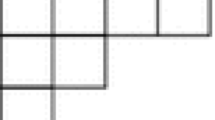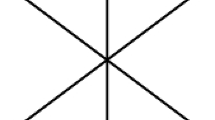Abstract
Given two combinatorial notions P0 and P1, can we encode P0 via P1? In this paper we address the question where P0 is 3-coloring of integers and P1 is a product of finitely many 2-colorings of integers.
We firstly reduce the question to a lemma which asserts that certain Π 01 -classes of colorings admit two members violating a particular combinatorial constraint. Then we digress to see how complex the class must be to maintain the constraint.
We weaken the two members in the lemma in a certain way to address a question of Cholak, Dzhafarov, Hirschfeldt and Patey, concerning a sort of Weihrauch degree of stable Ramsey’s theorem for pairs. It turns out the resulted strengthening of the lemma is a basis theorem for a Π 01 -class with additional constraints. We look at several such variants of basis theorem, among ahich some are unknown. We end up by introducing some results and questions concerning a product of infinitely many colorings.
Similar content being viewed by others
References
P. A. Cholak, D. D Dzhafarov, D. R. Hirschfeldt and L. Patey, Some results concerning the SRT 22 vs. COH problem, Computability 9 (2020), 193–217.
P. A. Cholak, C. G. Jockusch and T. A. Slaman, On the strength of Ramsey’s theorem for pairs, Journal of Symbolic Logic 66 (2001), 1–55.
R. G. Downey, N. Greenberg, C. G. Jockusch and K. G. Milans, Binary subtrees with few labeled paths, Combinatorica 31 (2011), 285–303.
D. Dzhafarov, L. Patey, R. Solomon and L. Westrick, Ramsey’s theorem for singletons and strong computable reducibility, Proceedings of the American Mathematical Society 145 (2017), 1343–1355.
D. D. Dzhafarov and C. G. Jockusch, Ramsey’s theorem and cone avoidance, Journal of Symbolic Logic 74 (2009), 557–578.
N. Greenberg and J. S. Miller, Diagonally non-recursive functions and effective Hausdorff dimension, Bulletin of the London Mathematical Society 43 (2011), 636–654.
D. R. Hirschfeldt, Slicing the Truth, Lecture Notes Series, Institute for Mathematical Sciences, National University of Singapore, Vol. 28, World Scientific, Hackensack, NJ, 2015.
M. Khan and J. S. Miller, Forcing with bushy trees, Bulletin of Symbolic Logic 23 (2017), 160–180.
B. Kjos-Hanssen, Infinite subsets of random sets of integers, Mathematics Research Letters 16 (2009), 103–110.
B. Kjos-Hanssen and L. Liu, Extracting randomness within a subset is hard, European Journal of Mathematics 6 (2020), 1438–1451.
M. Kumabe and A. E. M. Lewis, A fixed point free minimal degree, Journal of the London Mathematical Society 80 (2009), 785–797.
L. Liu, RT 22 does not imply WKL0, Journal of Symbolic Logic 77 (2012), 609–620.
L. Liu, Avoid Schnorr randomness, https://arxiv.org/abs/1912.09052.
B. Monin and L. Patey, The weakness of the pigeonhole principle under hyperarithmetical reductions, Journal of Mathematical Logic 21 (2021), Article no. 2150013.
B. Monin and L. Patey, Π 01 -encodability and omniscient reductions, Notre Dame Journal of Formal Logic 60 (2019), 1–12.
D. Seetapun and T. A. Slaman, On the strength of Ramsey’s theorem, Notre Dame Journal of Formal Logic 36 (1995), 570–582.
S. G. Simpson, Subsystems of Second Order Arithmetic, Perspectives in Logic, Cambridge University Press, Cambridge; Association for Symbolic Logic, Poughkeepsie, NY, 2009.
R. M. Solovay, Hyperarithmetically encodable sets, Transactions of the American Mathematical Society 239 (1978), 99–122.
W. Wang, Cohesive sets and rainbows, Annals of Pure and Applied Logic 165 (2014), 389–408
Author information
Authors and Affiliations
Corresponding author
Rights and permissions
About this article
Cite this article
Liu, L. The coding power of a product of partitions. Isr. J. Math. 255, 645–683 (2023). https://doi.org/10.1007/s11856-023-2475-y
Received:
Revised:
Published:
Issue Date:
DOI: https://doi.org/10.1007/s11856-023-2475-y




